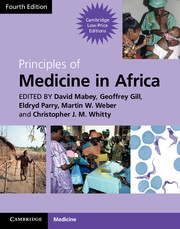Book contents
- Frontmatter
- Contents
- Contributors
- Foreword
- Section 1 Health and disease
- Section 2 Mother and child health
- Section 3 Infection: general principles
- Section 4 Major common infections
- Section 5 Bacterial infections
- Section 6 Viral Infections
- Section 7 Protozoal infections
- 42 Leishmaniasis
- 43 Human African trypanosomiasis
- 44 Amoebiasis
- 45 Intestinal protozoa
- Section 8 Helminth infections
- Section 9 Fungal infections
- Section 10 Non-communicable diseases
- Section 11 Diseases of body systems
- Section 12 Cancer and Palliative Care
- Section 13 Venoms and Poisons
- Index
- References
45 - Intestinal protozoa
from Section 7 - Protozoal infections
Published online by Cambridge University Press: 05 March 2013
- Frontmatter
- Contents
- Contributors
- Foreword
- Section 1 Health and disease
- Section 2 Mother and child health
- Section 3 Infection: general principles
- Section 4 Major common infections
- Section 5 Bacterial infections
- Section 6 Viral Infections
- Section 7 Protozoal infections
- 42 Leishmaniasis
- 43 Human African trypanosomiasis
- 44 Amoebiasis
- 45 Intestinal protozoa
- Section 8 Helminth infections
- Section 9 Fungal infections
- Section 10 Non-communicable diseases
- Section 11 Diseases of body systems
- Section 12 Cancer and Palliative Care
- Section 13 Venoms and Poisons
- Index
- References
Summary
The problem in Africa
The epidemiology of intestinal infectious disease has changed substantially since the 1980s in Africa. With the spread of HIV, parasites previously thought to be of minor importance have assumed a major profile and some previously unrecognized parasites have been found in human hosts. Cryptosporidiosis (infection with Cryptosporidium parvum) and isosporiasis (infection with Isospora belli) were thought of as unimportant occasional infections with protozoa of minor significance, while human infection with microsporidia was completely unknown before it was recognized in HIV-infected patients. These infections are now understood to pose important public health problems throughout the continent. Giardia intestinalis (also called G. lamblia or G. duodenalis), the first human protozoal parasite to be identified over 200 years ago with the first microscopes, remains an important parasite, especially of children. Although microsporidia have now been re-classified with the fungi, we consider them here as they cause a similar profile of problems to the protozoa.
These infections, with the exception of giardiasis, have a major impact on people who are immunocompromised because of HIV infection. Cryptosporidiosis is also important in children as it makes a major contribution to the persistent diarrhoea–malnutrition syndrome (PDM). It appears that cryptosporidiosis and microsporidiosis are equally prevalent all over the continent, but isosporiasis seems to be rare in the Sahel and in the Horn of Africa, while being common in sub-equatorial Africa. These infections are common among AIDS patients, and our own work indicates that multiple infections occur in up to 25 per cent of patients with AIDS-related diarrhoea.
- Type
- Chapter
- Information
- Principles of Medicine in Africa , pp. 429 - 433Publisher: Cambridge University PressPrint publication year: 2013



